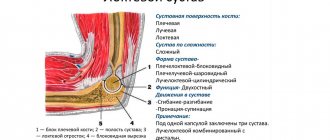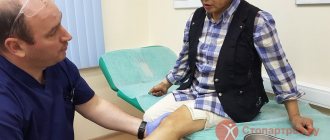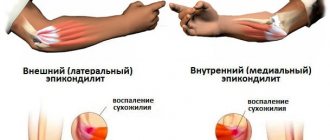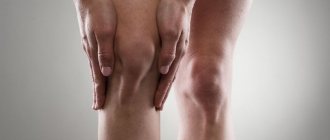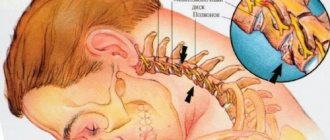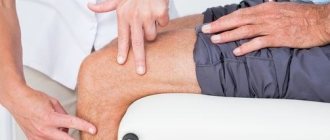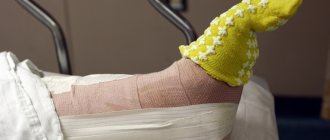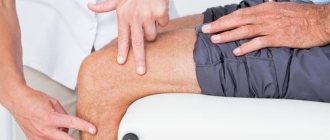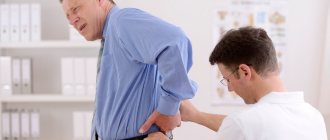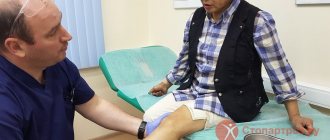Factors that provoke the occurrence of crunching in the knees
The appearance of a crunch in the knees during bending occurs under the influence of the following factors:
- If there is excessive stress, for example, when lifting heavy objects. People involved in professional sports often encounter similar problems with their knees. Such people often have to lift heavy objects and also overexert themselves when performing exercises that involve the lower extremities.
- When walking in uncomfortable shoes. High heels are harmful to both the feet and knees, as they lead to a shift in the center of gravity. In such a situation, the work of the joint increases significantly.
- For obesity. People with excess body weight often encounter a problem such as clicking in the knee joints, which is accompanied by painful sensations. In addition, such patients lose the ability to fully move and soon get tired. After some time, a destructive process begins in the joint tissue due to increased pressure on it.
- If there are no calcium-containing foods in the diet.
- With poor nutrition, excessive consumption of table salt.
- With insufficient production of hormonal substances. The occurrence of crunching occurs due to the fact that the cartilage wears out, which leads to the loss of its functionality.
Also, crunching and clicking in the joint may appear in the following cases:
- In the presence of pathological disorders in the knee joint: arthritis, bursitis, arthrosis, damage to tendon and ligament tissue, meniscus. Against the background of such pathologies, you can encounter not only the appearance of clicks in the knee, but also the appearance of pain, swelling and limitations in physical activity.
- After suffering leg injuries.
- With an abnormal structure of the knee joint, for example, with a congenital difference in the length of the lower limbs, flat feet.
- When leading a passive lifestyle, sedentary work, complete refusal to play sports.
- For osteoporosis. This disease is often diagnosed in old age.
- In professional athletes. Almost any sport involves the lower limbs, and they are maximally loaded. Regular training leads to gradual wear and tear of the joint tissue in the knees, which over time leads to the appearance of a crunch.
- Due to age-related changes. Over time, the volume of intra-articular fluid decreases, which contributes to wear and tear of the joint and loss of mobility.
Doctors' advice: how to get rid of crunching in joints?
To prevent and treat crunching in the joints, doctors recommend alternating physical activity with rest, not allowing the joint fluid to stagnate. Also get rid of bad habits - alcohol, smoking and excess coffee consumption accelerate the destruction of joints and reduce the effectiveness of treatment for cracking joints.
Physical activity
Avoid both inactivity and heavy loads on the joint. Any sports exercise should begin with a warm-up, which will “warm up” the muscles and prevent starvation of the cartilage. Aggressive sports, running, and strength training with cracking joints are contraindicated, especially if you have been diagnosed with inflammatory, degenerative changes, or joint hypermobility.
If the crunch in the joints is not associated with the individual anatomical characteristics of the patient, doctors recommend walking more (at least 40-60 minutes or 10 thousand steps a day, or 5-8 km) or cycling, swimming (2-3 times a week ), do Nordic walking or yoga. To track your activity, install a pedometer on your phone. Exercise should be done daily and systematically - do not try to catch up in a few hours 2 times a week. This can worsen the condition of the joint, because synovial fluid does not have time to be produced during intense exercise.
For arthritis and arthrosis, it is better to do not standard exercises, but a set of general strengthening exercises that help maintain the tone of muscles and ligaments.
Labor activity
Increased joint mobility, although not a pathology, can cause varicose veins or injuries due to high load on the joints. Taking this feature into account, it is better not to choose standing work. If you still have to stand, shift your weight from foot to foot more often, equip the place with a low bench on which you can place your foot from time to time. To prevent crunching in the joints, try to dilute the work in the same position with 10-15 minute warm-ups (3-4 during the day) - so-called. industrial gymnastics exercises. These include rotation of the head and torso, clenching and unclenching of fists, circular movements of the feet, hands, knees, and the “mill” exercise with the hands.
If necessary, use elastic bandages and restraints while working.
Weight
Regardless of the causes and treatment of cracking in the joints prescribed by the doctor, the patient needs to lose excess weight - it disrupts the healthy distribution of load between the joints, which is why the intervertebral discs of the lumbar region, hip, knee, and ankle joints begin to suffer. For example, 1 extra kilogram of weight is felt by the knee cartilage as 5.
Causes of crunching knees in children
It is interesting that not only adults, but also children sometimes experience a crunching sensation in their knees during bending. A similar phenomenon can occur against the background:
- Age characteristics. In babies under one year of age, connective tissue and muscles have not yet fully formed. When the child learns to walk, the problem will go away on its own without outside intervention.
- Genetic predisposition. Often, joint problems are hereditary and are passed on from parents to children.
- Development of arthritis. In such a situation, the baby often cries and behaves restlessly. The knee joint area becomes swollen and painful, so you should immediately consult a doctor.
- Hip dysplasia. This pathological factor is congenital. In this case, the length of the lower limbs is different, and asymmetry is observed in the inguinal folds. Treatment must be started immediately.
Knee reconstruction
After finding out the reasons why the knee crunches, treatment is prescribed that can be carried out:
- Folk remedies.
- Conservative methods.
- Operationally.
Conservative methods are those methods that are used to eliminate diseases of the musculoskeletal system using medications and other methods that exclude surgical intervention.
For this purpose:
- Non-steroidal anti-inflammatory drugs;
- Corticosteroids;
- Chondroprotectors.
This joint restoration plan is used in cases where the cause of creaky knees is an inflammatory process in the tissues, tendons or ligaments. If the cause is mechanical damage to the joints (cracks, fractures, bruises), then a plaster cast, splint or tight bandage is applied and complete rest is ensured until the end of treatment.
Surgical methods are used when restoration of joints with medications has not brought the desired result, and the knee still crunches, or when the disease is in the last stage of its course and it is not advisable to do anything with medications. For example, in stage 3 arthrosis, when the cartilage is completely destroyed, surgery is performed to implant a donor or artificial joint.
Restoring the knee with folk remedies if it is crunchy is not as popular as traditional medicine, however, it does take place. Manuals on alternative medicine contain a huge number of recipes used to treat joint diseases using folk remedies.
Folk remedies in the fight against joint problems
The fight against crunchy knees with folk remedies consists of using herbs or animal products. Most often, such events are aimed at the following:
- Reducing the amount of salts in the body.
- Increased volume of synovial fluid secreted.
For these purposes the following is used:
- Bay leaf;
- Salo;
- Garlic;
- Lemon;
- Gelatin.
For example, bay decoction is good at removing salts from the body, but it can only be taken if there are no problems with the kidneys.
To prepare the decoction, you need to take one and a half liters of water and 6-7 large bay leaves, cook after boiling for 15-20 minutes. Then cool and drink half a glass 3 times a day after meals. The course of treatment is 1 month.
Dissolve a pack (about 30 grams) of gelatin in water, heat it until hot, apply the mixture on gauze, wrap the knee, wrap it with cotton cloth on top, insulate it with a layer of woolen fabric and leave overnight. In the morning, rinse with cool water. The course of treatment is 1 month.
Diseases that provoke the appearance of crunching in the knees
The reason for the appearance of crunching in the knee joints may lie in the presence of certain pathologies. The occurrence of such a symptom is most often noted against the background of the development of these diseases:
- Gonarthrosis (arthrosis of the knee). With this disease, cartilage tissue wears out, which subsequently leads to joint deformation. This is often the reason for the assignment of disability. Women are more susceptible to the disease.
- Rheumatoid arthritis. This disease is a chronic inflammatory process in the joint tissue of the knee, which affects the synovial membrane. The cause of the pathology lies in excessive physical exertion, frequent injuries and damage to the knee.
- Chondromatosis. Often a unilateral form of the disease is diagnosed. In some cases, the disease transforms into a malignant neoplasm, although this happens quite rarely.
- Bursitis. This disease develops after injury to the knee joint, which leads to inflammation of the intra-articular cavity. In addition, pathology sometimes occurs due to excessive physical exertion.
- Osteochondritis. Over time, the cartilage plate that serves as protection for the bone peels off. The disease is found in people aged 20-40 years, mainly in men.
- Hypermobility syndrome. The reason for the crunch in this case is due to the fact that the mobility and flexibility of the joint is too active.
The cause of crunching during flexion and extension can be both pathological processes in the joint and previous injuries. In this case, the problem develops against the background:
- Injury to the meniscus. A similar problem has to be encountered if a person has jumped unsuccessfully, sharply turned his shin or straightened his knee.
- Dislocation. Problems with the functionality of the joint tissue cause clicking sounds, which are evidence of displacement of the membranes in the joint.
- Fractures. Injury to the femur, patella, and shin leads to clicking in the knee area.
- Ligament tissue injuries or sprains. The cause of the problem in this case is excessive stress on the joint tissue. This leads to a violation of the anatomy of the joints, which causes clicks to appear during movement.
It is worth noting that in some cases, the appearance of crunching in the knees is considered normal. If this phenomenon is not accompanied by hyperemia of the skin, pain and swelling are not disturbing, it is quite possible that there is no problem. Clicking sounds may indicate that the tendon and ligament tissue touches the bone when moving, which causes the crunching sound.
In addition, there are other safe reasons that lead to crunching in the knee joints:
- due to weakened ligamentous tissue, joints become more flexible;
- gas bubbles in the intra-articular fluid explode.
Why do teenagers' knees crack?
A crunch in the knee during extension in a teenager can occur for various reasons. The most common of them:
Congenital defects - abnormalities in the structure of the joint or bone tissue;
Increased elasticity of connective tissues - this symptom often occurs in adolescence during the formation of body tissues. Due to the increased elasticity of the ligaments, a slight displacement of the joint may occur, accompanied by a crunch when returning to its place;
Injuries – after sprains or ruptures of ligaments and tendons, severe dislocations, this pathology may be observed for some time, which resolves over time;
Excessive loads - spend up to 4-5 hours at school in one sitting position, most of the load falls on the knees, as a result this can lead to mild inflammatory processes, fatigue of muscles, ligaments, tendons.
Most of the reasons are relatively safe, and with the right exercise regimen and care, the crunch may go away. In adolescence, this symptom rarely indicates any serious pathologies.
But if it occurs regularly, it is still recommended to be examined by a doctor. In adolescence, when bone and other tissues continue to develop, timely detection of pathologies and anomalies will help avoid more serious problems in the future.
Associated symptoms
The appearance of a crunching sound in the knee area is not the only sign of the development of pathologies. Most often, in this case, the development of other accompanying symptoms is noted:
- pain syndrome of aching nature or sharp pain;
- hyperemia of the skin in the painful area;
- creaking in the knee area when changing position;
- burning sensations;
- feelings of numbness of the skin in the knee joint;
- the leg becomes completely swollen or swelling is observed in the area of the knee joint.
In some cases, accompanying symptoms are absent or mild. Occasionally, it manifests itself only partially, this is due to the pathology that caused the crunch.
Which doctors treat leg joint problems?
Usually, the first trip with complaints of joint pain begins with a trip to the therapist, who will have to find out the causes of discomfort and crunching, order and interpret laboratory tests and decide what treatment to prescribe or which specialist to send.
The following specialists can relieve knee pain:
- A neurologist who will eliminate neurological problems (if any), pinched nerve roots, lumbago and pulsation.
- An orthopedist who will eliminate the problems of the occurrence of the syndrome in orthopedic diseases (clubfoot, dysplasia, flat feet).
- A traumatologist who will begin to treat mechanical injuries, if they are the cause.
- An osteopath who uses his hands to relieve pain and relax muscles.
- Surgeon, if surgical treatment is required.
- A chiropractor who will continue the medicinal treatment with therapeutic massage.
In what cases is it necessary to seek medical help?
Crepitation that occurs during flexion and extension of the knee joint is considered common. Many people have to face this problem when they do squats or climb stairs. However, in some cases, crunching in the knees may indicate the development of a pathological process. If you notice other signs (swelling or pain) appearing against the background of clicks in the knee, you should consult a specialist.
When your knees are constantly crunching, you need to seek help from an orthopedist. It should be understood that timely detection of the disease and initiation of treatment will help to quickly cope with the disease, preventing possible serious consequences. In addition, if you seek specialized help in time, you can significantly reduce the symptoms that appear and resume motor activity of the knee.
When your knees begin to creak, you should contact the following doctors to identify the cause of the problem and eliminate it:
- To the traumatologist. Consultation with this doctor is required if the occurrence of crepitus clicks is associated with any injury.
- Neuropathologist. This specialist will help you get rid of the problem when the cause of its occurrence is a pinched nerve. This leads to pulsation or lumbago.
- Nutritionist. Consultation with such a specialist is required when the appearance of crunching and pain in the knee area is associated with obesity.
- Osteopath. Such a doctor will help in relaxing muscle tissue and eliminating pain.
- Orthopedist. When the cause of clicking in the knees lies in dysplasia, flat feet or other congenital diseases, you need to consult an orthopedist to eliminate the problem.
- To the surgeon. If the quality of life is impaired due to crunching in the knee joints, which manifests itself against the background of the progression of a serious pathology, surgical treatment may be necessary.
- To a chiropractor. Such a doctor should be contacted when massage procedures have been prescribed for therapeutic purposes for knee problems.
What can a crunch cause?
If your knee crunches when straightening, you need to undergo an examination to find out the exact reasons for what is happening. Depending on whether the patient has any disease or pathology, there may be different consequences.
In particular, this symptom may indicate the following diseases:
Anomaly in the development of ligament and tendon tissue - in the future it can lead to rupture of the connective tissues of the joint, which will require surgical intervention;
Consequences of injury - if clicking continues for a long time after a sports or other injury, there may have been errors in the provision of medical services, in particular, the ligaments fused incorrectly or the joint was incorrectly adjusted;
Consequences of inflammatory diseases - inflammatory diseases lead to the destruction of cartilage tissue, which provokes the appearance of extraneous sounds during joint activity. If timely measures are not taken, inflammation can lead to decreased limb mobility, increased pain, and the development of chronic diseases.
You can only assess the scale of the consequences if you know exactly the causes of the disease or deviation.
Diagnostics
To make an accurate diagnosis, the doctor first interviews the patient to find out some important details:
- were there any other signs that preceded the appearance of crunching in the knees?
- whether the person has a genetic predisposition;
- whether the patient is sick with something else.
When the visual examination and questioning of the patient is completed, the doctor may recommend certain diagnostic procedures:
- magnetic resonance therapy (MRI);
- arthroscopic examination of the knee;
- ultrasound diagnostics;
- radiography
Based on the results obtained after the study, the doctor accurately diagnoses the disease. This will allow you to choose the right treatment in each specific case. How effective the prescribed therapy will be is largely determined by the advanced stage of the disease. You should not ignore the symptoms and wait for them to disappear on their own.
Diseases
What diseases cause crunchy knees? For those associated with damage to cartilage tissue, inflammatory processes or injuries.
The infectious agent disrupts the physiological balance inside the knee and triggers destruction processes. Swelling, inflammation, changes in the composition of fluids - all this leads to crunching and pain.
Crackling and crunching noises begin to appear while walking up stairs, when bending your legs, even from a lying position. This way you can clarify whether there is a crunch or not. Usually you can hear it well.
If the crunching causes discomfort, you should see a doctor. Moreover, doctors are different. Someone will send you home with the words: “don’t invent a disease for yourself,” but someone will actually help. So don’t despair if the doctor turns out to be the most mediocre creature on the planet. There will always be a normal specialist.
Drug treatment
The selection of medications depends on what exactly caused the crunch in the knees. In this case, treatment with the following drugs may be prescribed:
- complex vitamin preparations containing phosphorus and calcium;
- corticosteroids containing hormonal substances;
- external medications to relieve pain and restore motor activity in the damaged joint;
- chondroprotectors in the form of capsules or ointments to strengthen cartilage tissue;
- anti-inflammatory drugs, the purpose of which is to relieve pain and inflammation. Such signs appear as concomitant symptoms against the background of crunching in the knees (drugs in this group are usually prescribed to patients with arthritis).
Which medications and in what dosage the patient should take is decided by the doctor after conducting appropriate research. Certain groups of drugs are potent drugs, especially hormone-containing drugs. Their use without medical advice is prohibited.
How to treat and for how long
Therapy is carried out in two directions: symptoms are relieved and the cause of their appearance is corrected. So, if a patient complains that the knee has cracked and now hurts, the doctor may prescribe drugs from the NSAID group: they help reduce pain, inflammation, and swelling. Corticosteroids, which are anti-inflammatory hormones, may also be administered. If the knee crunches when straightening, but does not hurt, the doctor may prescribe vitamin and mineral complexes. Chondroprotectors can improve the condition of cartilage tissue and slow down destructive processes.
Important: even if your knee crunches when walking, but does not hurt, you should not self-medicate: without an examination it is impossible to make a correct diagnosis.
Diet food
During the entire course of therapy, the patient will have to adhere to a special diet prescribed by the doctor. Dietary nutrition involves increasing the consumption of foods containing calcium, for example, dairy products. In addition, regular consumption of low-fat fish is recommended - it also benefits bone tissue and cartilage. An important role is played by the consumption of such products from childhood, while the development of the body continues.
If you experience crunching in your knees, you will have to eliminate all kinds of sauces, preservatives, marinades and table salt from your diet. It is necessary to limit the consumption of sweets; it is better to include fresh fruits and vegetables in the diet instead of confectionery.
Surgical treatment
Surgical intervention for creaking knees is recommended only in situations where it is not possible to get rid of the problem using conservative methods.
In such a situation, the following is indicated:
- arthrotomy of the knee joint;
- arthroplasty
- punctures to determine the pathology and goal of therapy;
- tenorrhaphy
- meniscectomy
- arthroscopy
- synovectomy
- osteosynthesis
Typically, surgery is performed on patients who have the following problems:
- there is a foreign object in the joint cavity;
- received a fracture;
- you need to replace the knee joint with a prosthesis;
- ligamentous tissue is torn;
- damaged meniscus;
- diagnosed with rheumatoid arthritis that is not amenable to drug therapy;
- Hematomas do not heal well, which requires removal of the pathological contents.
Anatomy of the knee joint
The knee joint is called complex because it has several articular surfaces. It connects the femur, tibia, and patella (kneecap). The quadriceps femoris muscle is connected to the patella by a tendon that continues with ligaments.
The knee consists of:
- articular capsule;
- articular cavity;
- ligaments;
- cartilage;
- articular surfaces of bone heads;
- synovial chambers with fluid.
Meniscus in the knee joint
The ligamentous apparatus of the knee consists of lateral, posterior and intra-articular ligaments. The articular surfaces of the bones are covered with cartilage tissue. Between the mating surfaces of the femur and tibia there are internal and external menisci (cartilage pads), so the knee joint is considered complex.
The knee contains bursae, the size of which varies individually. Their inner surface secretes a special lubricant, synovial fluid. Lubrication allows all elements of the joint to move easily and freely.
Structure of the knee joint
Rehabilitation therapy for cracking knees
If the patient is bothered by crunching in the knees, the following therapy is recommended to restore functionality in the joints:
- Physiotherapy. Classes can only be started with the permission of the attending physician. If you start exercising too early, you can damage the joint tissue and make the situation worse.
- Swimming. This sport does not put much strain on the knees, so over time it is possible to restore lost functions.
- Physiotherapeutic procedures. This type of therapy consists of massage and thermal procedures. In combination with other restorative techniques, such procedures have a beneficial effect on the articular tissue of the knee.
Let's look at the benefits of restorative therapy:
- slight load on the damaged joint;
- rapid recovery after surgery;
- high probability of complete restoration of motor activity of the knee joint.
The disadvantages of restorative treatment include the following:
- Ligaments can be damaged;
- the disease will begin to progress if the use of restorative techniques is not started in a timely manner.
Prevention of knee joint diseases
To keep your joints healthy and strong, you must follow these rules:
- Healthy, moderate diet, rich in vitamins and minerals.
- Controlling your body weight is very important: the stress on your knees increases significantly as you gain weight.
- Enough clean water daily.
- Moderate physical activity on a regular basis.
- Comfortable shoes that do not restrict movement (heel no more than 3 - 4 cm).
- Contact a doctor promptly if alarming symptoms appear.
Gymnastic exercises
Gymnastics helps prevent knee deformation and maintain muscle tone. You can perform the exercises when the doctor has cleared the load on your knees, since otherwise you can further harm your joints.
To get rid of crunching knees, you can do the following exercises:
- Sipping. While we are lying in bed, we stretch our upper and lower limbs.
- Bend your knees. We lie down on the floor face up and alternately bend our knees, and our feet should not leave the floor.
- "Bike". We lie on our backs, bend our knees and twist them, imitating riding a bicycle.
- Rotation. We stand near the chair, leaning on the back with our hands, alternately rotating our knees in one direction and the other. The exercise must be repeated 10 times.
- Squat. We stand near a chair, lean on the back and squat 10 times.
The movements must be slow and smooth, otherwise you can harm your knees. If sharp pain and swelling appear after completing gymnastics, it is better to stop exercising for a while.
Briefly about the structure of the knee
We promise not to burden you with the anatomical complexities of the knee joint. Although, the joint is really complex. To understand why the knee is so vulnerable, let's look inside it, what is there under the skin?
And there are several structures connected together - the heads of the tibia and femur, the meniscus and ligaments, due to which this entire structure is held together. If you touch your kneecap, you will notice that it is mobile. Now imagine how complex nature has come up with everything to ensure mobility and, at the same time, strength and physiologically correct functionality of the knee joint. This is not your elbow, although that one is also not entirely simple.
Inside the knee there is joint fluid. If it is deficient, severe friction of the bones against each other will begin, the knee will swell and lose all mobility. By the way, you may have already begun to understand why your knees may hurt. For example, due to lack of joint fluid.
Why the knee may suffer:
- Violation of the structure of any component of the joint (cartilage, bone, ligaments).
- Violation of the composition or volume of joint fluid.
- Violation of the composition of cartilage and ligaments.
These are the reasons why the knee crunches when squatting. If one of the listed conditions appears, it becomes much easier to damage the knee than in a healthy body. In a normally functioning body, the knee can be damaged only by putting a huge load on it, that is, by tearing a ligament or damaging the cartilage. But the knee will immediately swell and be very painful.
It’s a different matter for the problems indicated under points 1, 2, 3. Violations occur gradually, and it all starts with a crunch (a click is heard when bending). So, let's talk about that crunching and clicking sound that many people hear when walking up stairs, squats and other movements associated with bending the legs at the knee.
Massage
Performing a massage helps to activate blood circulation and improve mobility in the knee joint. Moreover, you can massage the injured knee either yourself or by contacting a specialist.
If you decide to engage in self-massage, you should follow these rules:
1. Use ointments, for example, containing bee venom.
2. You need to massage your knee lightly and carefully, without using force.
3. Squeeze a small amount of ointment onto the knee area and rub it in using gentle movements in a circle.
4. The product should be smeared on both the front and back areas of the knee joint.
5. At the end of the procedure, it is recommended to wrap the knee with an elastic bandage.
6. The optimal time for massage is at night. At this time, the leg warms up better and remains at rest for a long time.
How do you know when it's time to see a doctor?
In itself, crunching in the joints is not a pathology and is even reassuring - with advanced joint diseases it is physiologically impossible.
You need to be concerned about a cracking sound in a joint if it is accompanied by:
- a feeling of friction - as if sand had gotten between the heads of the bones;
- pain that intensifies with movement;
- unusual tension, twitching in the muscles even at rest;
- swelling of the joint and increase in its volume, engorged soft tissues;
- limitation of mobility in the joint;
- a feeling that the joint is “jammed” - possibly a foreign body in the joint capsule;
- redness of the skin over the joint, local increase in temperature;
- a feeling of numbness in the muscles, their weakness, up to impairment of gait or fine motor skills.
Healthy crackling occurs periodically. A simple example: if a gas bubble collapses in a joint, when you move again, there will be no more crunching noise, no matter how much you bend the limb. But the pathological one is heard constantly and only intensifies over time. The specificity of the sound also differs. A loud, dry crunch is quite normal. But if you hear something rough, “with a grinding sound,” check with your doctor for the causes and treatment of crunching in the joints.
ethnoscience
To speed up the recovery process in damaged cartilage, you can use alternative medicine. Folk remedies help relieve symptoms associated with crunching in the knee joints.
Let's take a look at some recipes:
- Oatmeal compresses. Oatmeal in the amount of 1 tbsp. Fill a spoon with a glass of hot water and apply the prepared mixture to the affected area. You need to make sure that the compress remains warm. The duration of the procedure is approximately half an hour.
- Pine decoction. Take 1 spruce cone, fill it with clean water in a volume of 200 ml, and infuse overnight. The finished infusion should be taken orally twice a day, 1 tbsp. spoon. Duration of admission – 10 days.
- Lemon lotion. Mix lemon juice (10 grams) and vegetable oil (50 grams). We moisten a piece of clean cloth with the resulting mixture and apply it to the damaged knee, leaving for 40 minutes.
- Decoction with parsley. Mix parsley with celery root in a container. Pour 500 ml of boiling water over the resulting mixture and cook for 5 minutes. After removing from the stove, cool and strain, then add honey (2 tablespoons) and lemon juice. We take the finished product daily for 30 days, 5 sips. Then we take a break and repeat the therapeutic course if necessary.
It is worth noting that the use of folk remedies can only bring results in combination with traditional methods of treatment. Therefore, you should definitely consult your doctor before starting to use such recipes.
What can make your knee creak?
A crunch in the knee joint can be caused by its hard structures, including:
- Terminal section of the femur.
- Proximal tibia.
- Menisci and patellas.
- Articular cartilages and capsules.
Moreover, either one or several knee elements can crunch.
Sometimes extraneous sounds are caused by lesions in the soft structures of the knee, in which case they are explained by a violation of the equivalence between the hard articular surfaces.
